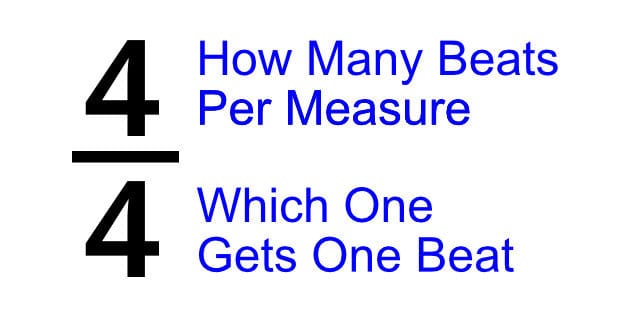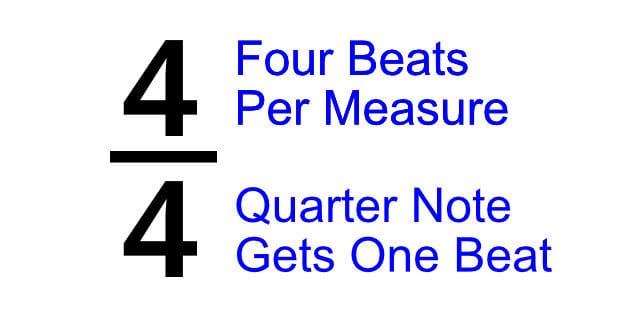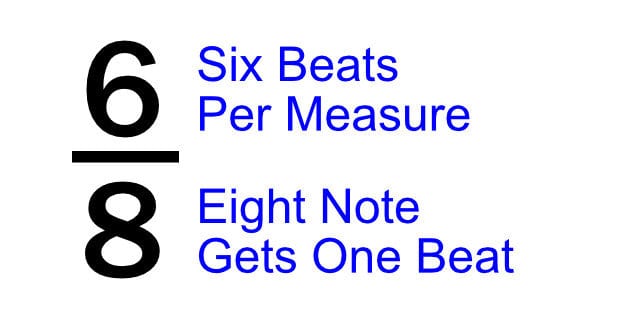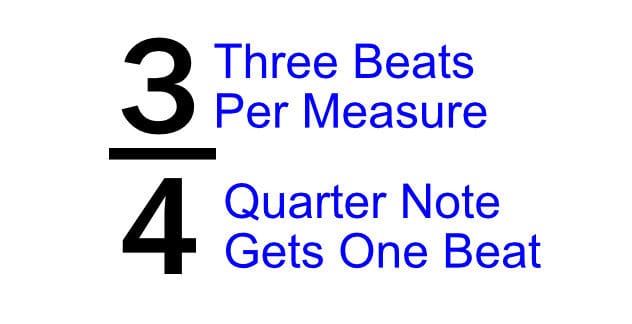A lot of beginner (and even intermediate) guitar players tend to stay away from music theory. I think that most people find the idea quite intimidating. But here’s a secret about music theory:
It’s actually pretty simple at its basic level. Like 3rd grade math simple!
Sure, music theory can get pretty complex. But for 80% of musicians all we need to know (and then some) is entirely accessible.
What Are Time Signatures?
Time signatures define how many notes are in a measure, and what note gets the accent. That sounds complicated, but I’ll show you three examples of the most common time signatures (that you’ve probably already played).
In any time signature you have two numbers. Sometimes they’ll be next to each other, and sometimes you’ll see the numbers stacked. They mean the same thing.
The first (or top) number is how many beats are in the measure. The second number is what note value gets the accent.

Beats and Tempo
Before we go any farther, let’s define a beat. The easiest way to think about a beat is that it’s what you tap your foot to when you listen to a song. Think about the song Twist And Shout, or listen to it here if you need a reminder
Now tap your foot or clap along. Each of these taps or claps is a beat.
It’s important to note that tempo isn’t the same as a time signature. Tempo only tells you the speed of the song.
4/4 Time Signature
Let’s use Twist And Shout again. This song is in 4/4 (four-four) time. This is the most common time signature. It’s also referred to as standard time in some circles.
The first 4 means that there are 4 beats in the measure. The second 4 means that the quarter note gets the accent. This is your standard “one-two-three-four, one-two-three-four” count.
If you turn on the radio right now, you have a 90% chance of hearing a song in 4/4 time.

6/8 Time Signature
The next time signature is 6/8 (six-eight). The first number tells us that there are six beats in the measure. The second number tells us that the eighth note is the accent.
6/8 time has a very specific feel most of the time. If you were counting the measure it would sound like this:
One-Two-Three-Four-Five-Six
One-Two-Three-Four-Five-Six
Notice how there is more emphasis on the “one” and the “four”. This is the most common way to play something in 6/8.
House Of The Rising Sun is a great example of 6/8 time. Listen to the version by The Animals and count along. You’ll notice how fast the counting is. That’s because the eighth notes are being accented.

3/4 Time Signature
You might think that since 3/4 is half of 6/8 that they would have similar feel. But 3/4 (three-four) time often feels more like 4/4 with one less note.
So with 3/4 time you have 3 beats per measure, with the quarter notes having the accent. With the 3/4 time signature the 1 of every measure tends to have the most emphasis.
One-Two-Three
One-Two-Three
Sometimes you’ll hear a bigger emphasis on the 1, and sometimes it’s more subtle.
Happy Birthday is an example everyone knows that uses 3/4 time. Sing it out loud and clap your hands. You’ll notice that the measures all end after the third beat.

Are There Other Time Signatures?
Yes! And while they’re fun to use and write music in, they also get a little more complicated. In popular music, you really don’t hear anything outside of 3/4, 4/4, and 6/8 time. By understanding these three you’ll be able to tell the time signature of 95% of the songs you’ll ever hear!
Want some more help?
Need some help with strumming and rhythm? If you're a Real Guitar Success Academy member, check out the lesson:
The Beginner’s Journey | Strumming & Rhythm.
This course includes 34 video lessons plus Play-Along videos, Virtual Band tracks and PDF downloads.
Not a member yet? No problem. Sign up here FREE for 14 days. I’m hoping you stick around… but if not, the 2 weeks should be enough time to get the benefit from this lesson.

I hope I can take lesson from you I am slower then most so I will try on freebey for awhile and hope to be able to get there like you say 80/20